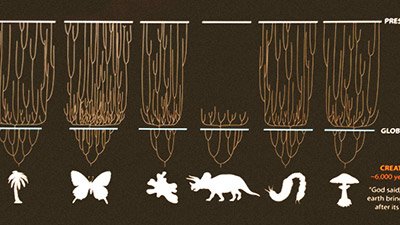
Evolution Without Molecules-to-Man Evolution
If molecules-to-man evolution is a myth, why does evolution seem to explain some scientific observations? Or can mechanisms underlying fish “evolution” be understood without appealing to molecules-to-man evolution?
News Source
- ScienceDaily: “Seeing How Evolutionary Mechanisms Yield Biological Diversity”
In October 2008 we covered research into the “evolution” of fish known as cichlids in Africa’s Lake Victoria. New research from the same team further investigates cichlids, showing how “over 60 species of cichlid fish from Lake Malawi and Lake Victoria have adapted their visual sensitivity in response to specific ecological factors, including what they eat and the clarity of the water in which they swim.”
The diversity of cichlid species can be traced back to initial genetic differences “processed” by the engine of natural selection.
The researchers began by asking why so much cichlid diversity exists. Honing in on the genes that allow cichlids to detect different wavelengths of light, the scientists discovered that variations in the expression of these genes create “alternate visual systems” among the cichlids. This variation, against the backdrop of differences in African lakes, is a major factor in cichlid diversity.
More specifically, some cichlids’ vision range is spread over shorter wavelengths while others use longer wavelengths. One factor motivating the difference is the diet of the cichlid species: those whose diet consists of zooplankton—small organisms that absorb ultraviolet light—are more likely to have a visual range that includes ultraviolet sensitivity. The other key factor is the clarity of the water in which a cichlid species swims: cichlids living in the murky waters of Lake Victoria use longer wavelengths, which best allows them to see the light that penetrates the murky depths; those living in the clearer waters of Lake Malawi and some clearer spots in Lake Victoria rely on shorter wavelengths.
Of course, natural selection can explain this variation: cichlids whose eyes are suited for clear waters will not survive long in murky waters, and vice versa. Likewise, if a cichlid cannot see its prey and consequently cannot eat, it will not survive. Thus, the diversity of cichlid species can be traced back to initial genetic differences “processed” by the engine of natural selection.
That process, if repeated for millions of years, would lead to the development of new cichlid species. For example, perhaps an eyeless cichlid species would thrive in the darkest depths of Lake Victoria. But what that process cannot describe is the origin of the genetic information that makes a cichlid a cichlid or that makes eyes in a supposed cichlid ancestor that had no eyes. Lake scum undergoing natural selection for millions of years would never evolve into a cichlid population because evolution cannot explain the origin of genetic information. So while this research offers yet another solid example of the workings of natural selection (a concept creationists understand and research), it offers no support for the evolution of all life (a great amount of genetic information) from a single common ancestor (a small amount of genetic information).
Further Reading
- Is Natural Selection the Same Thing as Evolution?
- Get Answers: Genetics, Information Theory, Natural Selection, Speciation
For More Information: Get Answers
Remember, if you see a news story that might merit some attention, let us know about it! (Note: if the story originates from the Associated Press, FOX News, MSNBC, the New York Times, or another major national media outlet, we will most likely have already heard about it.) And thanks to all of our readers who have submitted great news tips to us. If you didn’t catch all the latest News to Know, why not take a look to see what you’ve missed?
(Please note that links will take you directly to the source. Answers in Genesis is not responsible for content on the websites to which we refer. For more information, please see our Privacy Policy.)

Answers in Genesis is an apologetics ministry, dedicated to helping Christians defend their faith and proclaim the good news of Jesus Christ.
- Customer Service 800.778.3390
- Available Monday–Friday | 9 AM–5 PM ET
- © 2025 Answers in Genesis

